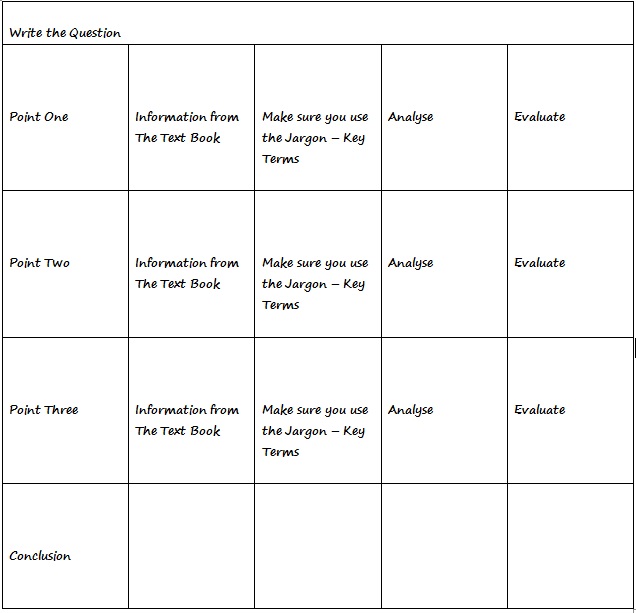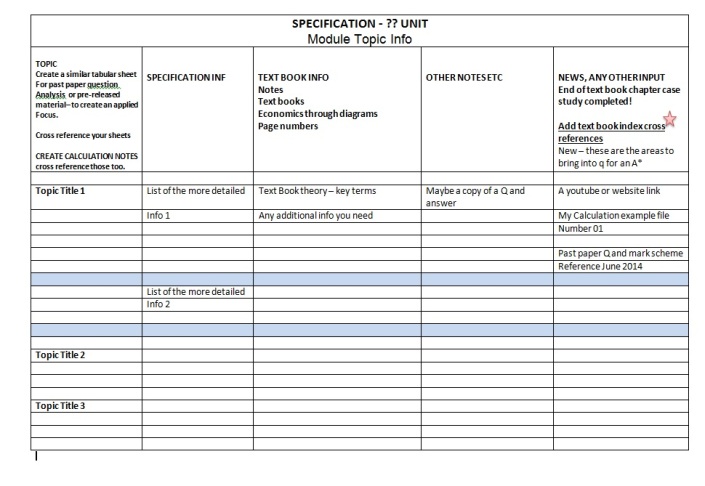This is a tough system – but if you want excellent results and can be self disciplined and stick to it and include regular updates and keep building information step by step each week, the System will work for you.
It’s not easy – Learning Systems are not simple and its not often that you are given
any advice on HOW TO LEARN.
The Business Studies Alevel Revision Plan – this starts from week one of the first week of the term you begin to study.
If you start later – you may need a tutor to help see the online tutoring websites
Each Subject has a set of Resources – Specifications, Schedules for teaching, Teacher Resources, Past Papers and Answers. Check the Examination Board website and under qualifications find your specification – make sure you have the right one …Double check!
Download it … read it…
Create your own resource to work with your School-College-University-Tuition system Notes
We are going to make a File that will look like a TEXT BOOK that will be your own resource.
You can Answer any question or topic using this plan – but you do have to learn the info as you go along.
Gaining an A* can be as time consuming and as difficult as learning to play an Instrument and it needs the same amount of practice If you wish to become an expert – you need to complete dedicated hard work
FIRSTLY
Organise your time and make it a lifestyle. …
To organise your time (if you think its a good idea) you can reassure your child-self about personal non study time by being a kind of seafarer with ‘watches’ so you can get some sport, telly watching, friends time and you will know that it’s ok time.
Divide the waking hours of your day into 6. Three chunks of time should be your own in non examination time (it includes meal times and travel and fun time) and you just have two ‘time chunks’ when the pressure is on.
The three (or four) non personal times should cover your time in your Educational Establishment and your additional non contact work hours. You may need to go with a little less sleeping time if it doesnt all fit but 7 hours sleep should be maintained.
On top of your School Learning and you need to complete your own study (non contact time). Family Life people often include Homework in this time.
EAT PROPERLY – you can only concentrate if you have the correct, ‘right’ nutrients. This means for an adult or a teenager 40 g of PROTEIN each day, without this you will not be able to concentrate or even breathe properly – Protein is Meat, Fish, Eggs, Cheese or Nuts or Tofu or Milk or Beans. There are 4-5 g of protein in a glass of milk. If you drink hot milk you need to include that skin that forms on the top of the cup or mug as that is the Protein. Wholemeal flour has TONS of protein in it and making quiches, pastries, crumbles or just home-made bread can boost your protein. There are other sources like porridge oats … You will find that around half an hour after consuming a meal or snack with protein in it your concentration is much better. Do not skip meals while you learn or revise – treat yourself kindly and properly. This goes for the whole time you are as student and continues all through your lifetime. For example despite all info to the contrary if a Student at Sixth Form or Uni can manage a full English breakfast (or just a bacon sarnie) they have a good chance of reaching the 40g of protein in a day kk
Next – what exactly have you got to learn in the time towards the Examination?
You need to look for some info:-
Finding the ‘system’s – Establishment – Examination board learning Info. You need to know your Examination Board and the Subject Specification Title and reference number.
Teachers rarely show you the Specification for the Subject – It is on the Examination Board Website. It’s really informative but scary.
You have Two years at A Level to learn all the topics. That’s a number of topics a week – Teachers call that the Schedule.
The subject specification links should also have a list of resources that you need to work with towards the end of the Specification document.
Make a list of the resource websites – use your computer or a library computer and go to each site and either copy the link or bookmark it
(depending on whether it is your computer where the bookmarks are saved) A USB stick is useful.
Buy the most comprehensive text book they recommend and/or a Revision Guide.
Become very disciplined and very organised.
Print a Copy of the Specification – Tick each topic off the Specification as you are taught it.
Maybe make a set of cards with the topics on so you can test yourself.
Check if there is an MBA App on the Android or iphone market with similar info (often Americanised)
Use the Relevant and most useful Textbook. (At worst use the most relevant Revision Guide)
Some subjects have books on Amazon for just £1 which are older text book versions with mostly the same information with the exception of Business Company Case Studies as businesses change.
Work through the Questions at the end of each Chapter.
Memorise the Key Terms
Essays
Read this Carefully, once you understand the steps, the system becomes simple and effective
– your essays almost write themselves
– You can make a kind of Business Studies Game out of learning the Keywords
– your revision becomes simple to remember.
Parents family and friends groups, round the class, groups students…can work together to read and help fill in the tables.
Group Learning for Homework Essays
One person has the specification module info, one the textbook and the student the question or case study/research… You, the student asks for the module info, then the text book info and writes in their table… the student only, of course, completes the analysis and evaluation column…
Teamwork without compromising the student!
A tip for degree students … add a further column for citations and you can use the plan at degree leve l
From 2015 mostly – the Examinations are Linear and Essay based – you will mostly start your research for answers to a question with the left hand column.
Data Questions you might start with the second column – a mind map could help to gather all the different topics for Synoptic modules (all the modules together)
BTEC and Tech Levels you might need to have ‘Evidence’ based assessments – and these may work with this system
but practical work is not quite the same.
Create one of these plans for the end of Chapter Case Study questions – in column 2 either write the topics that are in the Text book chapter
you are working from, or check your specification for the broad topic and list the sub-topics.
COLUMN 3 IS MOST IMPORTANT – USE IT TO MAKE YOUR NOTES FROM YOUR TEXT BOOK
ADDING THE POINTS YOU NEED – FOR EXAMPLE
1 2 3 4 5
TOTAL REVENUE SPEC INFO TEXT BOOK ANY CASE OTHER LINKS INFO
COPIED KEYWORDS NOTES VIDEO/USEFUL URL
.
Column 1 – Write The question
Column 2 – in this column enter the topics and subtopics from the Text book Chapter and/or the exam board Specification (links in the footer) make sure the Topics are in rows or chunks of rows (write basic or amplified topics depending the on time you have available – study through the year, or last minute revision)
Maybe a sheet of paper for each main topic and sub topics.
Use the exam board website – even the teacher notes, complete the whole Specification using the Text Book Chapters, over weeks on your own or work as a group – find your subject carefully use as many pages/rows as you need
Column 3 – Relevant Text Book Information is really important. The revision notes should really be made all year round READY for revising…not at the last minute
You need info relevant to topic in specific table rows, Kewords, Definitions and/or Notes and/or Website info
Column 4 – Case Study or Research Information relevant to the each topic row
Columns can now become pages of information and notes.
The final Column 5 – enter your Analysis and Evaluation relevant to the topic rows (each topic may of course use more than one actual row in the table …topics come in chunks usually linked to the spec subsections, analysis and evaluation may mean linking several together.
becomes your conclusion page.
Write several rows in each column or on each page to each topic and then a new title for the next chunk
You then have a PLAN (the table with info in columns) and PAGES of info supporting your Case Study or Question. HOPEFULLY in a REALLY NEAT file. Now Each time you have a question or case study on a topic in a Chapter – you have a file of information to refer to. If you have highlighted the topic headings it should be much more simple to find answers to case studies and questions.
It really isn’t possible to learn just the text book info – you have to be able to apply it in different ways. Using a system to answer the Text Book end of Chapter questions gives you the means to apply the information from each main topic.
Once you have an understanding of the concepts – the table and columns should be enough for an essay plan
Your Teacher-Lecturer should be encouraging some similar kind of thorough information gathering process however they may have their own resources and not use the text book ones which mean your learning cant be followed through at home easily.
Please don’t use spreadsheets to write your subjet info, you cant edit it properly. Obviously they can be useful for calculations.
Use whatever paper suits you to make an essay plan in columns, even flip chart paper…or a word file (save and backup) or even make a blog!!
If you are still struggling with writing Essays – make a similar Table in Word (or on a huge piece of paper) with big squares and each row becomes a paragraph (two if you have lots of info).
A Levels and degree modules are not simple – there is alot of information to learn –
This system looks like extremely hard work on an ongoing basis – buy hey – you could be training to be a Doctor or a Nurse and have to learn Latin too!!
Good Luck
Co-Opt a Family member to do some writing for you – cards for Key Terms for example.
It’s a really old fashioned way of learning – but it works. At the end you have done so much reading and writing that three
hours in an examination room seems like a breeze!
Make sure your File has File Dividers and is really clear and easy to read. You can check the End of Chapter Case Study question answers with a Teachers Answer Resource book – or ask the Teacher/Lecturer if they will photocopy the end of chapter answer pages for you – or even mark your answers.
Check the Past Papers on the Examination Board Subject Specification (make sure you have the right Examination Board and Specification Reference number) with the Mark Schemes to make sure you understand the kind of answer and information that the Examiner will be looking for.


